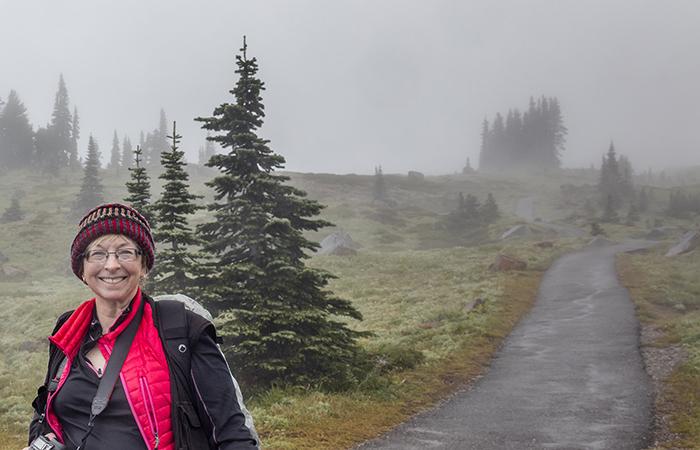
Where is the mountain? Somewhere behind me. Mount Rainier National Park / Rebecca Latson
While I don’t want you to think you should battle hurricane conditions to photograph within a national park, I do want you to know that inclement weather should not stop you from venturing out to capture amazing images. All you need is the right gear and a different mindset. Don’t let bad weather ruin your photographic day.
I recently returned from an early September visit to Washington state, where I spent three days in Mount Rainier National Park. During that entire time, it rained off and on with low-hanging clouds and swirling fog. Mount Rainier (aka The Mountain) remained in hiding. I was granted an audience with the top of The Mountain for maybe 5 minutes on the day of my arrival and 20 minutes on the day of my departure.
That first 5 minutes of the mountain was during my early morning stopover at Tipsoo Lake. After oohing and aahhing over the gorgeous images on Flickr.com of Mount Rainier reflected in this small, glacially-created body of water, I departed my sister’s comfy home in Yakima at dark-thirty a.m. to wend my way up Chinook Pass in an effort to make it to the lake as close to sunrise as possible. The photo below shows you how much I actually saw of the mountain, re-shrouded after a few clicks of the shutter button.
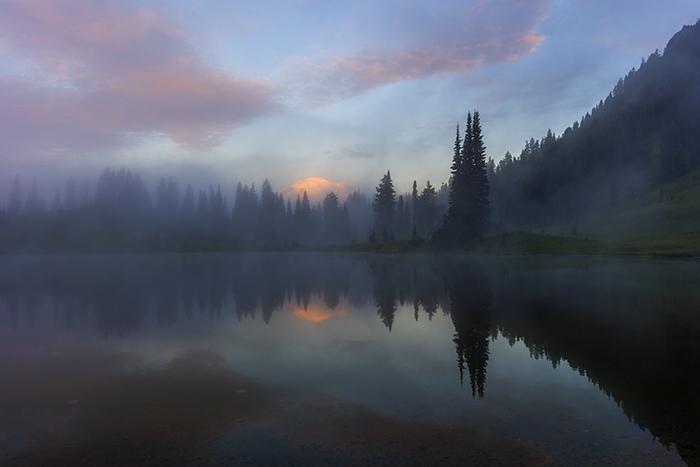
A misty sunrise at Tipsoo Lake, Mount Rainier National Park / Rebecca Latson
I hung around for another 30 minutes to capture various aspects of this beautiful little venue, which I feel may occasionally get missed in a photographer’s zeal to capture the mountain with the lake as an accessory. The fog and low-hanging clouds were great accoutrements to the chill morning atmosphere. The images you see were taken with the camera on a tripod and I used my graduated neutral density (grad ND) filter to keep the white of the fog-layered sky from being blown out (overexposed) as I metered for the darker portions of the composition.
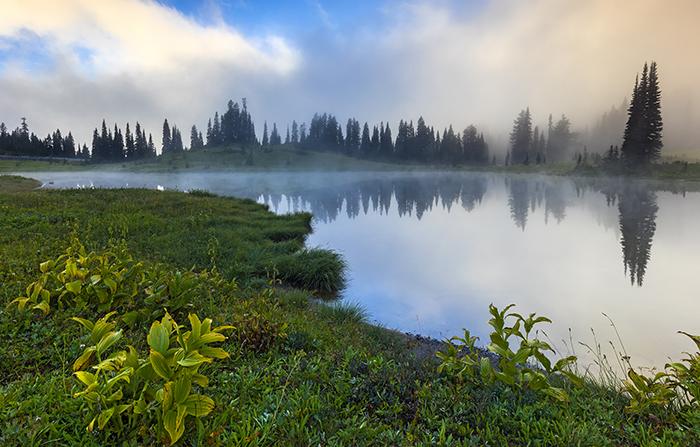
Morning view along Tipsoo Lake, Mount Rainier National Park / Rebecca Latson
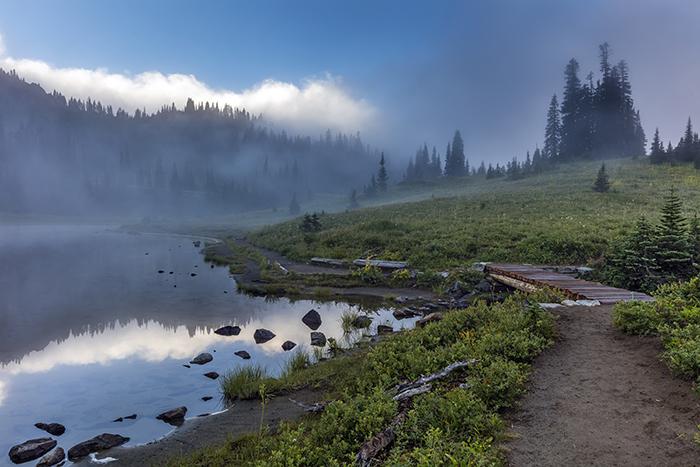
The trail around Tipsoo Lake, Mount Rainier National Park / Rebecca Latson
As I continued my ascent to the Paradise area of the park, I periodically stopped to soak in the views and photograph the little waterfalls I saw along the way. Despite the episodic rain, fire danger was rated high and the creeks, rivers, and falls were down to a trickle.
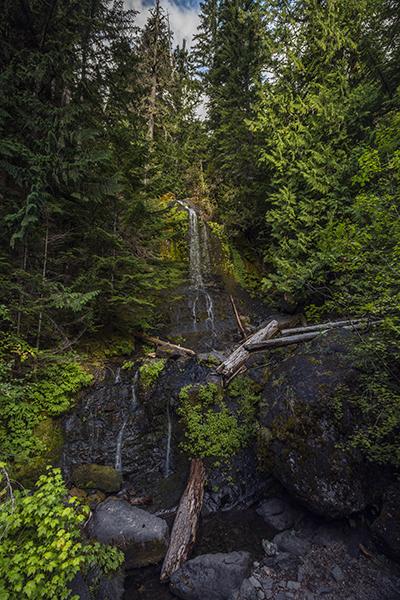
The waterfall at Falls Creek, Mount Rainier National Park / Rebecca Latson
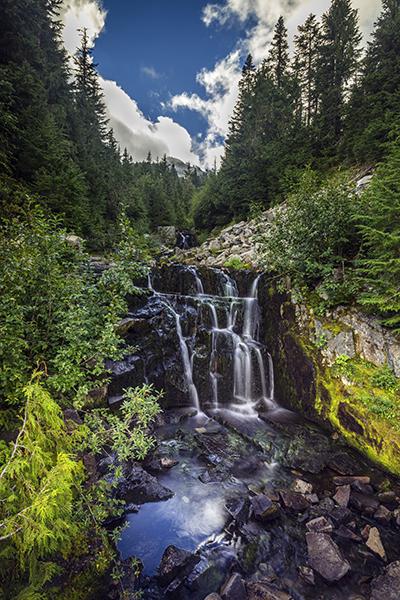
The waterfall at Sunbeam Creek, Mount Rainier National Park / Rebecca Latson
While in Mount Rainier National Park, I stayed at the Paradise Inn. The place was packed! What a difference, though, a little bad weather (and the end of the Labor Day holiday) can make. The very next morning, I stood in the cold and rain to capture exterior shots of the inn with its warmly-lit windows. Having remembered to bring along my rain gear for myself and my cameras, I traipsed out into the elements while other lodge guests remained indoors, bemoaning the weather and the fact they couldn’t see Mount Rainier. Not as many people like to get out on the trail during bad weather, which, in turn, translates into the good fortune of a photographer to capture otherwise normally-crowded scenes, like Myrtle Falls. The previous (non-rainy) day, people were scrunched cheek-by-jowl for a nice view of the falls. On this morning, it was me, myself, and I. Sure, no mountain loomed in the background, but the lack thereof in no way detracted from this beautiful little waterfall. For the “silky-water” in the composition, my camera was placed on the tripod and I used my Singh-Ray Vari-ND variable neutral density filter, which is a neat “dial-a-shade” type of filter. This neutral density filter (not to be confused with the grad ND filter) darkened the composition enough for me to use a very slow shutter speed to achieve that smooth-water effect without blowing out the lighter elements of the scene.
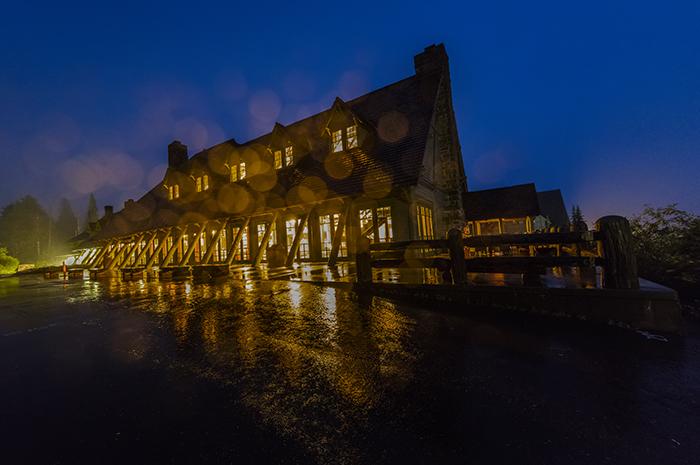
Paradise Inn in the rain, Mount Rainier National Park / Rebecca Latson
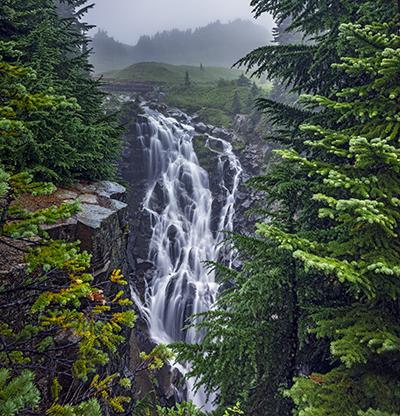
Myrtle Falls on a rainy morning, Mount Rainier National Park / Rebecca Latson
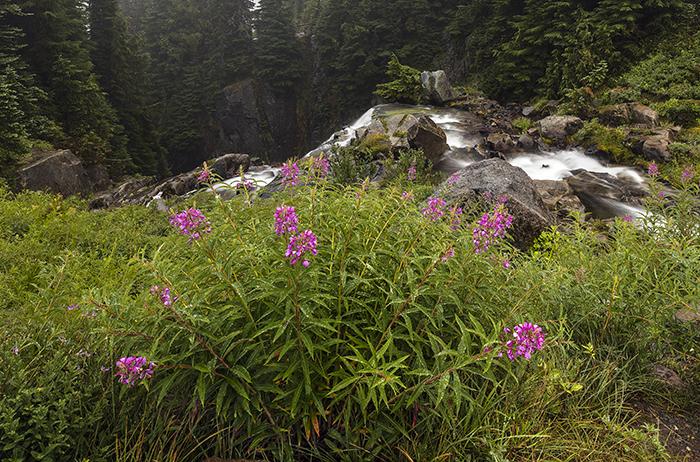
Looking down Myrtle Falls, Mount Rainier National Park / Rebecca Latson
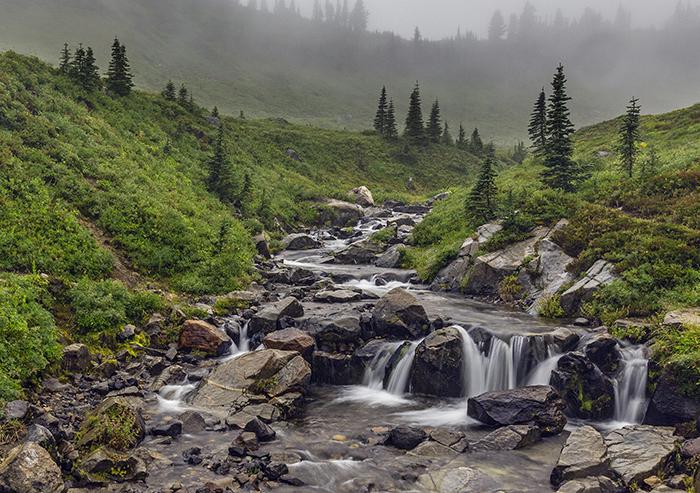
Looking up from Myrtle Falls, Mount Rainier National Park / Rebecca Latson
No matter how far up I hiked the trails within the Paradise area, I never managed to totally escape the swirling fog, which grew thicker with increasing elevation. Thus, Mount Rainier remained totally shrouded. So, I directed my camera to what I saw immediately around me instead. I captured great close-up images of a blue grouse mother and chicks, deer, marmots, and adorable little chipmunks. I photographed sparkling droplets of water on leaves. I took pictures of scenic vistas I might have overlooked in my single-minded pursuit of mountain shots, had the weather been clearer. I noticed nuances of shadow and light as the clouds and fog sped and swirled over the mountain meadows and marveled at the brilliant rain-saturated greens of trees, grass, and plants. I can’t honestly say I would have spent as much time with this had Mount Rainier been visible in all of its volcanic and glaciated glory.
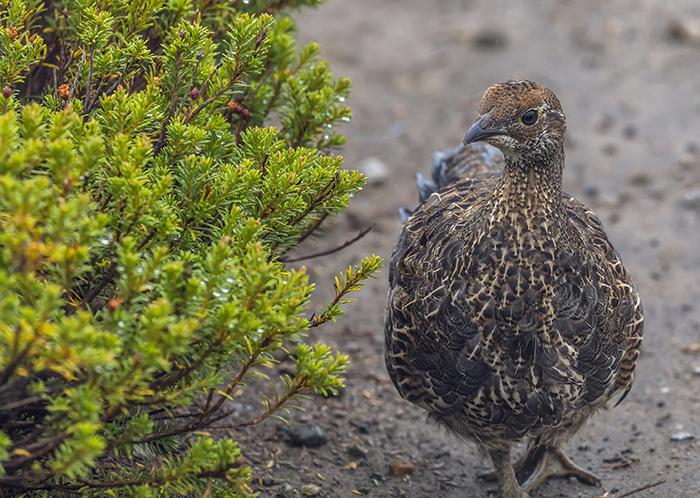
Blue Grouse chick, Mount Rainier National Park / Rebecca Latson
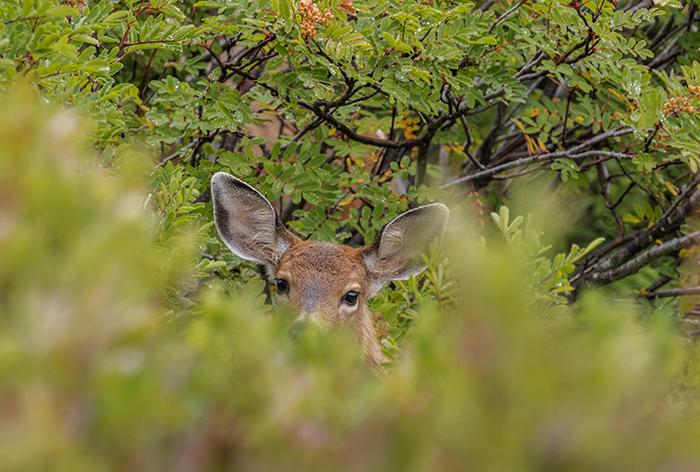
Deer peeking, Mount Rainier National Park / Rebecca Latson
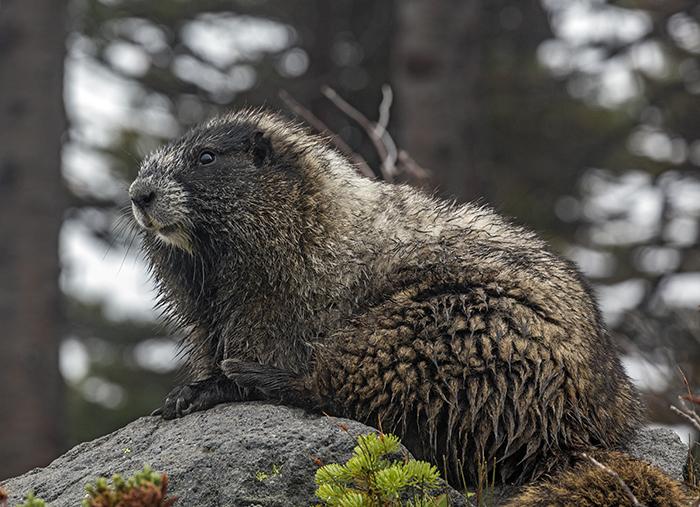
Marmot on Skyline Trail, Mount Rainier National Park / Rebecca Latson
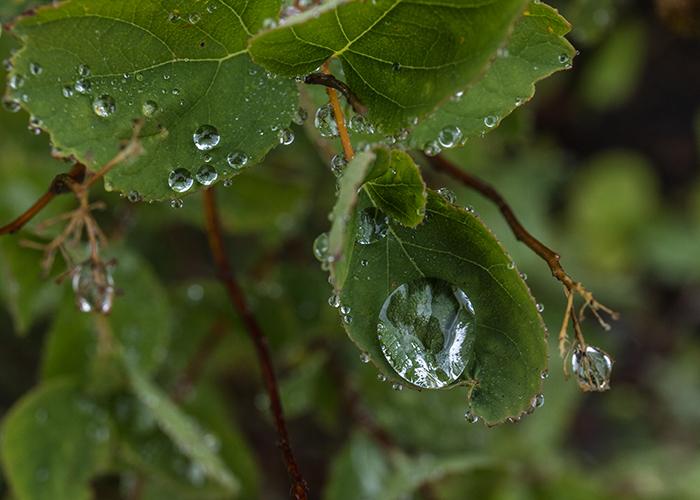
Rain droplets, Mount Rainier National Park / Rebecca Latson
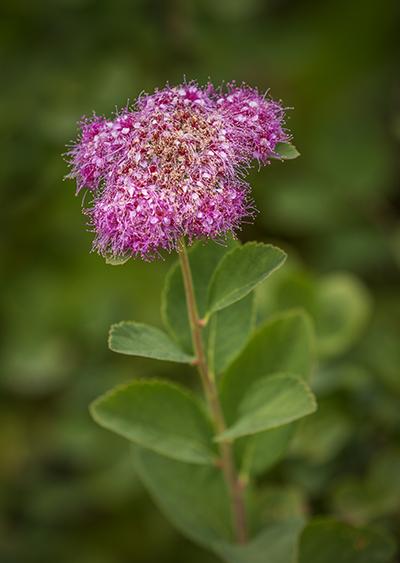
Rosy Spirea, Mount Rainier National Park / Rebecca Latson
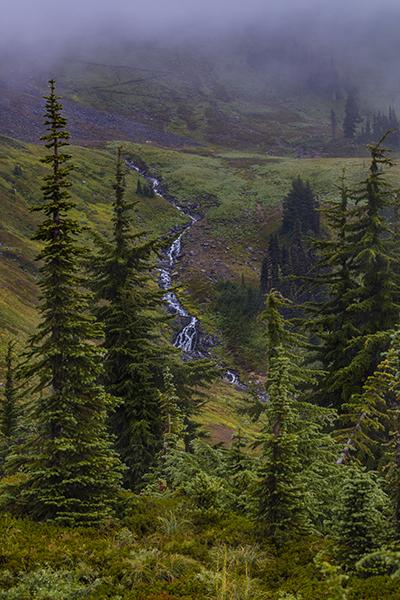
Fog, falls, and forest along the Alta Vista Trail, Mount Rainier National Park / Rebecca Latson
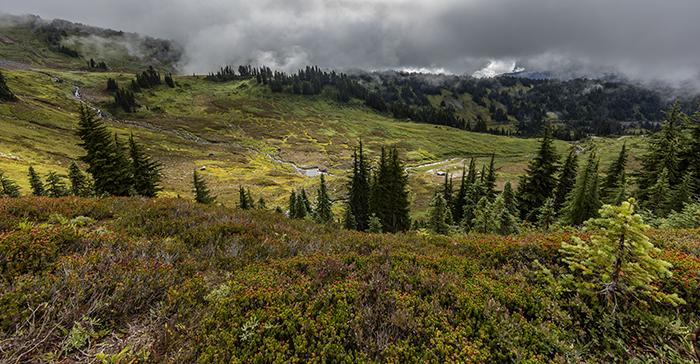
The view at Alta Vista, Mount Rainier National Park / Rebecca Latson
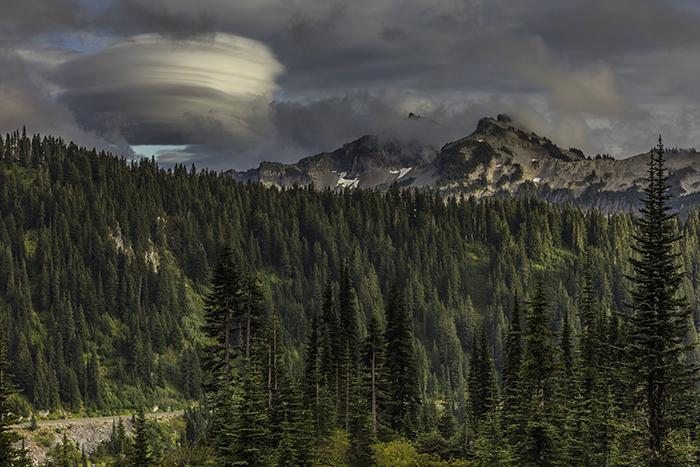
The view from my lodge room: the Tatoosh Range and a lenticular cloud, Mount Rainier National Park / Rebecca Latson
Packing For Rainy Weather
- Rain Jacket – In addition to the prerequisite cold-weather hat, jacket, and fleece top to wear in the chilly mountain air, I packed along my rain jacket I’d purchased from LL Bean. The fabric of this style is light, but doesn’t necessarily hold up well under a sustained downpour. Nonetheless, I knew before I left Texas that I’d get hot and sweaty after even a short climb up a steep trail, so I chose that jacket with the lighter fabric as opposed to my sturdier waterproofed field jacket from AquaTech.
- Camera Rain Protection Covering - There are all sorts of water-repellant coverings out on the market for your camera and lens. Go to a site like B&H Photo or Adorama and do a search on “rain protection.” For my camera, I took along a couple of Vortex Media-brand "Storm Jackets". This brand of protection comes in several sizes and colors to fit both short- and long-lens setups. I own other coverings as well, and the Storm Jacket is really more water resistant than waterproof. However, it’s light and easy to scrunch up and stuff into a pocket. I took two because if one became totally waterlogged, I could switch it out for the other dry one, if necessary. I had no intention of keeping my camera out in a driving rainstorm, so the Storm Jackets fulfilled their purpose. When shopping for your own camera rain protection, keep in mind the degree of waterproofing as well as ease of handling on-camera when determining what brand of rain covering you might wish to purchase.
- Lens Hood - Another trick you can use alone or in combination with your camera’s rain covering is to attach the lens hood. Normally, you use it to prevent glare spots, right? A lens hood also does a pretty decent job of keeping out rain drops, to a certain extent, depending upon the shape of the hood and how heavily it is raining. My 16-35mm lens hood was great at preventing water droplets with the camera in the horizontal position on my tripod, but not so much with the camera in the vertical position because of the lens hood’s "petal" shape. The lens hood on my 100-400mm lens, however, worked very well in keeping the rain off the lens because of the hood’s tall, uniform shape.
- Cleaning Cloths – I always remember to pack a couple of pocket-sized microfiber lens cleaning cloths. While they don’t work that well at quickly cleaning and drying a soaking lens, they *do* work nicely when clearing away the occasional odd water droplets.
I won’t lie to you, I am disappointed I did not get to see and photograph The Mountain for any length of time. The shot below was taken at Reflection Lake, on my way out of the park. I stood in along the trail, waiting for the wind-driven fog and clouds to clear up enough for me to get a quick image of the mountain top. Mount Rainier finally did totally emerge from hiding ... on the gloriously clear day I left Seattle to return to Texas. Sigh. It just wasn’t in the cards for me this visit and, in a way, I felt like it was meant for me to not see The Mountain. Because I was not totally preoccupied in seeking out Mount Rainier, I instead saw and photographed features of this incredible park I might have otherwise neglected. I took my own advice from the article I wrote for last month’s column. Maybe I’ll see Mount Rainier during my next visit. In the meantime, I returned to Texas with some wonderful images and sweet memories of the cedar-fragranced air and haunting, fog-swirled scenes in Paradise, all because I didn’t let a little bad weather stop me and my camera.
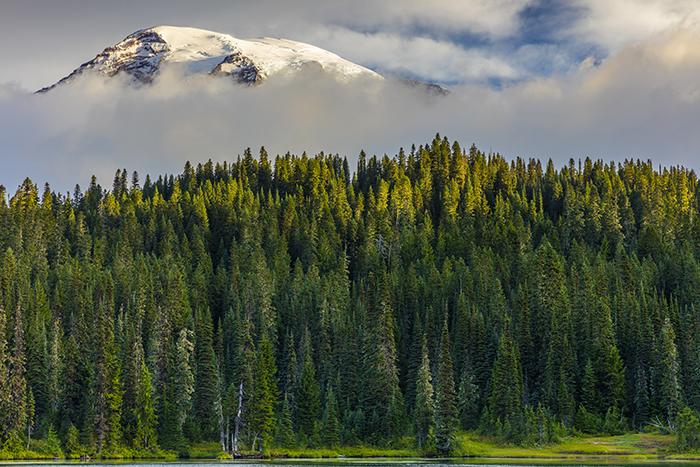
A morning view of The Mountain at Reflection Lake, Mount Rainier National Park / Rebecca Latson



Comments
Thanks for another enjoyable article!
And great images!
Thanks for another great article. I know some of my best photos were in cloudy situations, so I don't ususally hesitate to get out there.
Excellent pictures
I had the good fortune to see it both ways. Bright sunny day and the next day we woke to low clouds and fog.
Had a good time both days taking pictures of this awesome park.
Nice story and super pictures,Rebecca
.